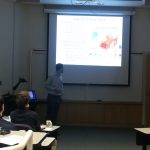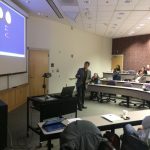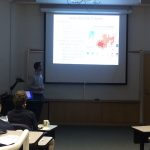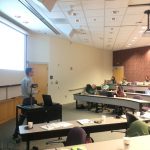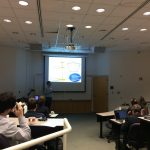The second UMBC Earth Day Symposium featured 14 oral and 11 poster presentations from the Atmospheric Physics Department, Joint Center for Earth Systems Technology (JCET), University of Maryland, National Oceanic and Atmospheric Administration (NOAA), George Mason University, the Science and Technology Corporation, and NASA. UMBC Atmospheric Physics program professors are linked to their research pages in the Department of Physics.
Invited Talks
Zhibo Zhang, UMBC
The Aerosol Cloud Radiation Observation and Simulation (ACROS) group at UMBC
Pius Lee, NOAA
The challenge of air quaility forecasting, especially for places downwind of larger polluters
Eugenia Kalnay, UMD
Population and climate change: HANDY model
Nathan Kurtz, NASA
Remote sensing of the polar regions with operation IceBridge and IceSat-2
David Whiteman, NASA/HU
Raman lidar and application to atmospheric profiling
Pengwang Zhai, UMBC
Phytoplankton photocompensation: radiative transfer modeling and applications
Reed Espinosa, NASA
Aerosol properties retrieved from in-situ measurements of light scattering and absorption made over the contiguous United States
Barry Klinger, GMU
Ocean circulation, heat uptake and climate
John Sullivan, NASA
Overview of the 2017 OWLETS: summary of observations and initial results
Christopher P. Loughner, NOAA
Impact of historical air pollution emissions reductions on human health during extreme heat
Omar Torres, NASA
Satellite-based atmospheric remote sensing using near-UV observations
Peter Colarco, NASA
Importance of dust particle size in the Earth system and treatment in the NASA Goddard Earth Observing System (GEOS) model
Amir Ibrahim, NASA
Atmospheric correction for hyperspectral ocean color sensors
Christopher Barnet, STC
What can weather satellites tell us about climate?

